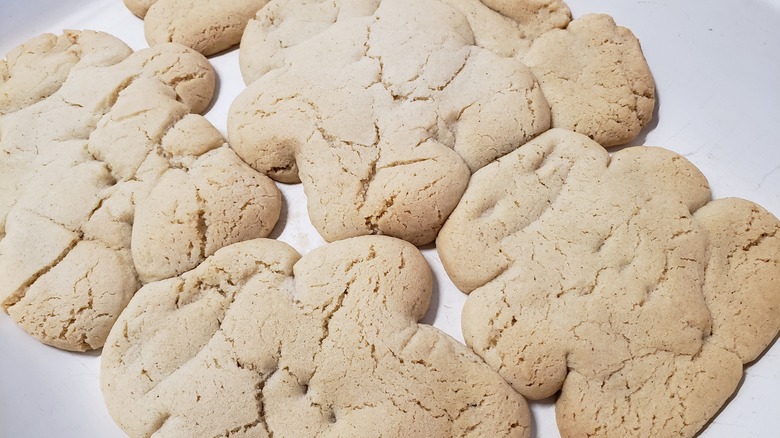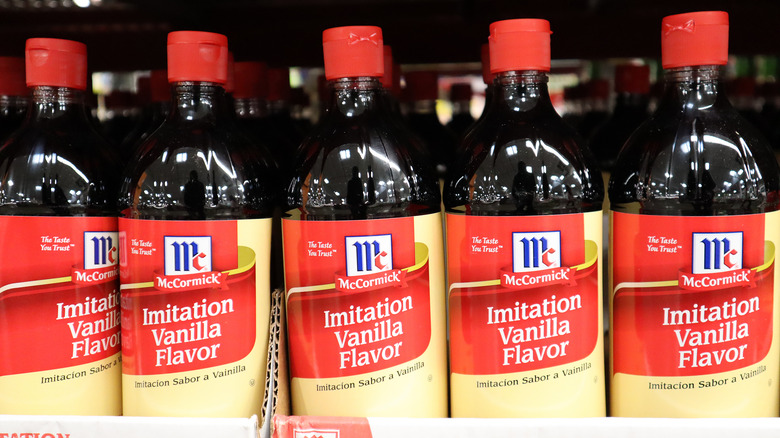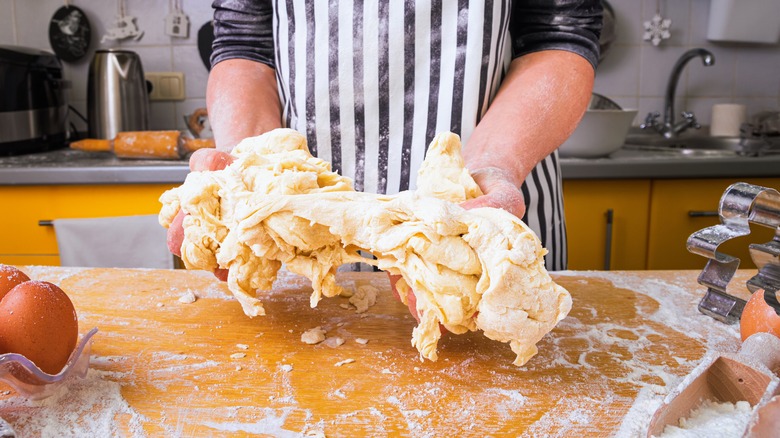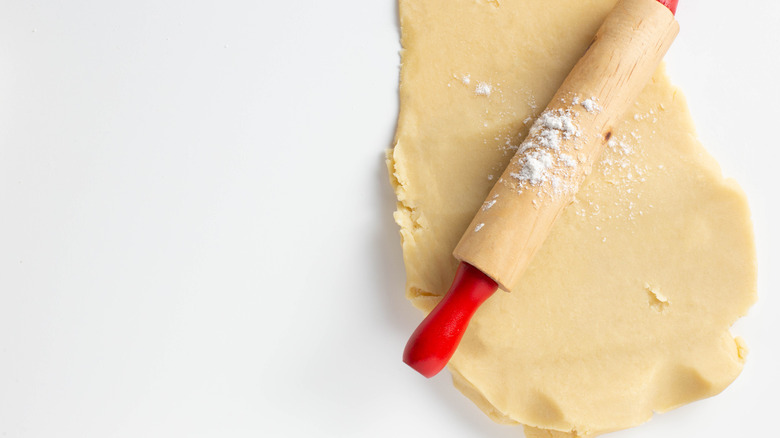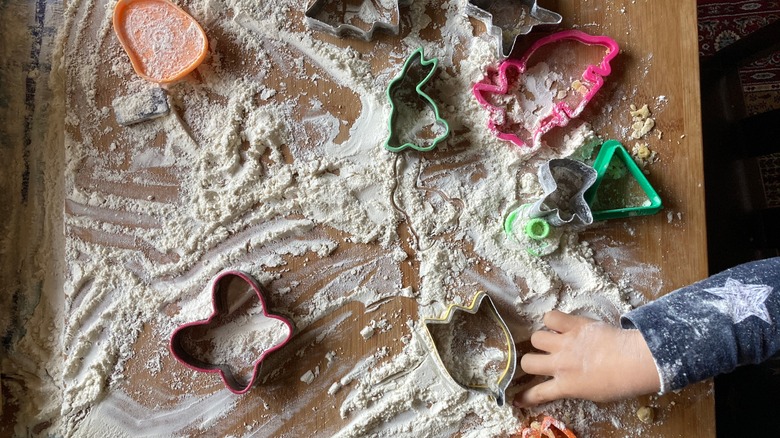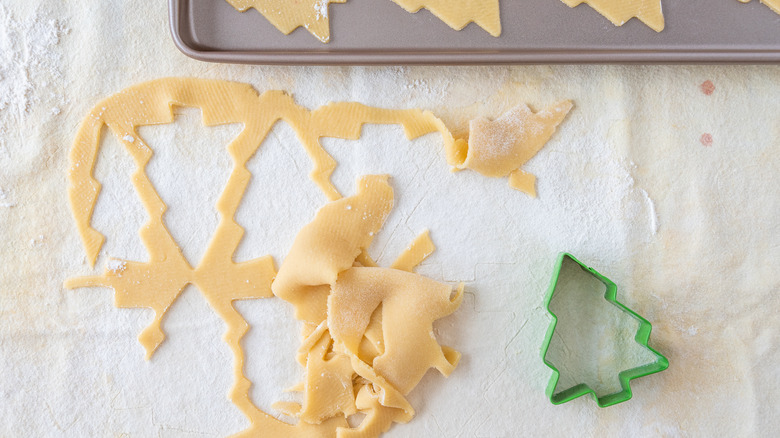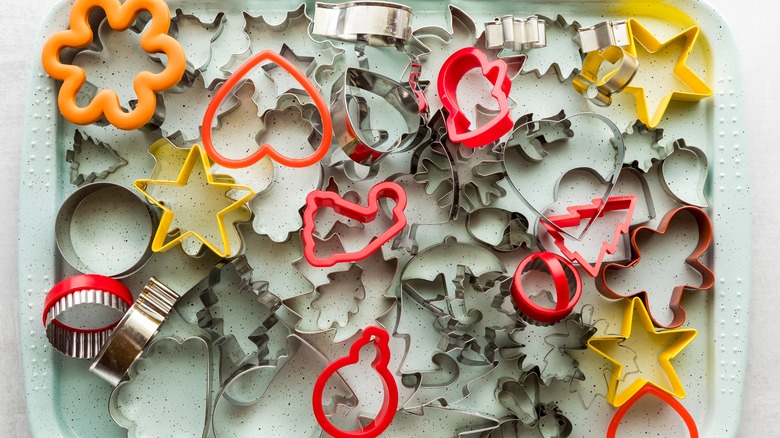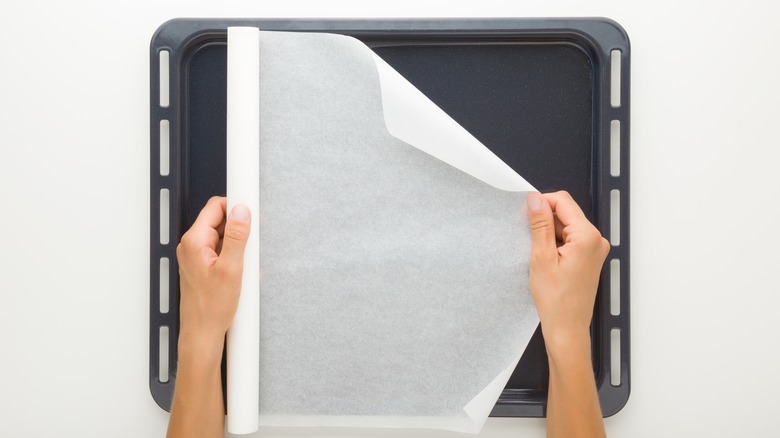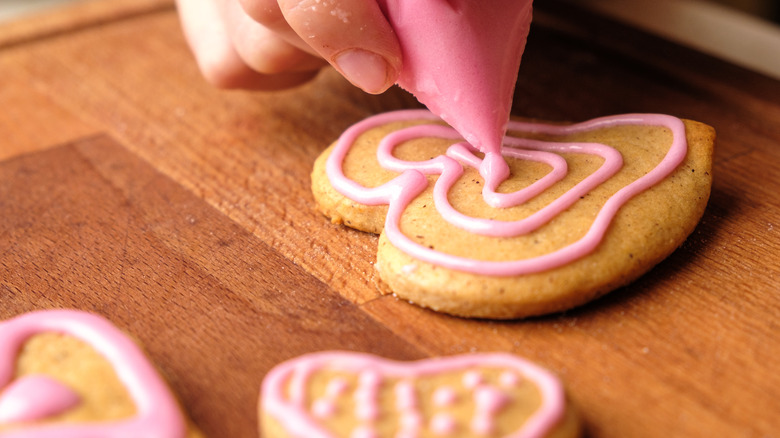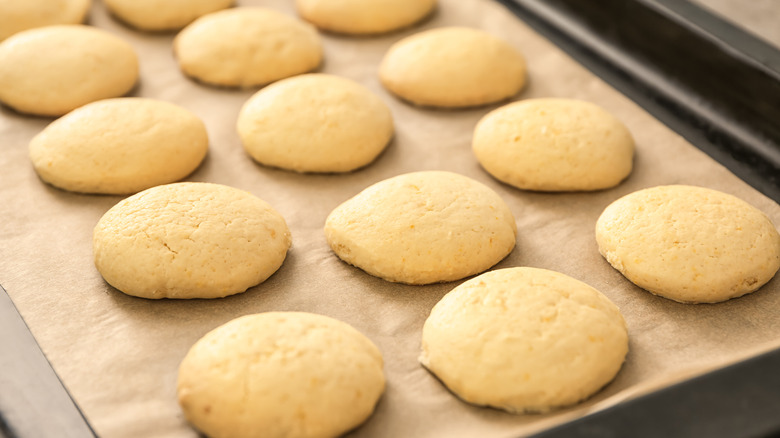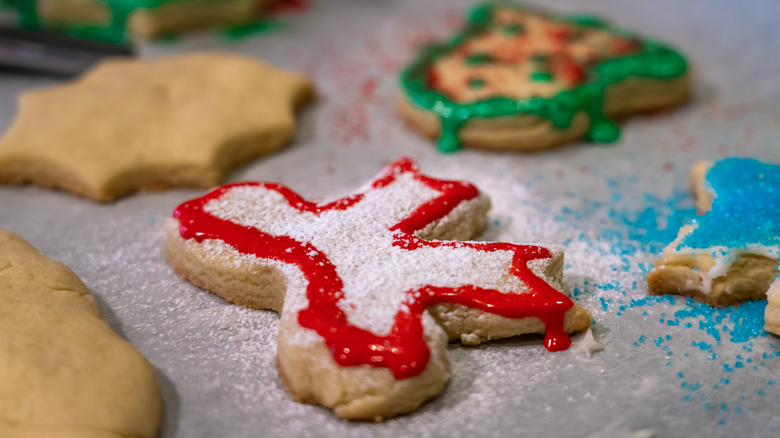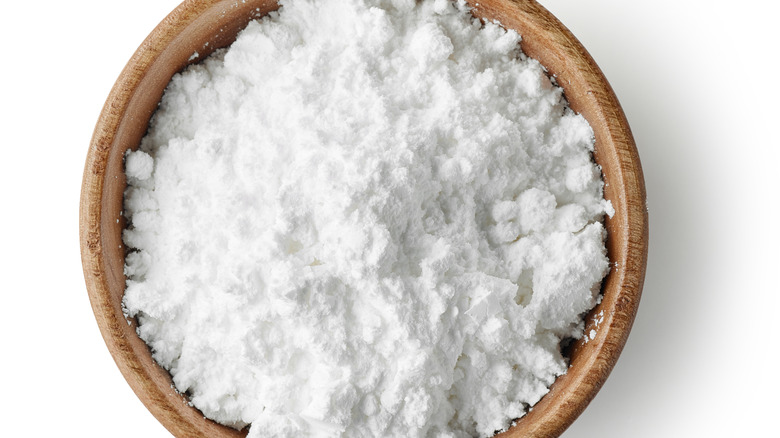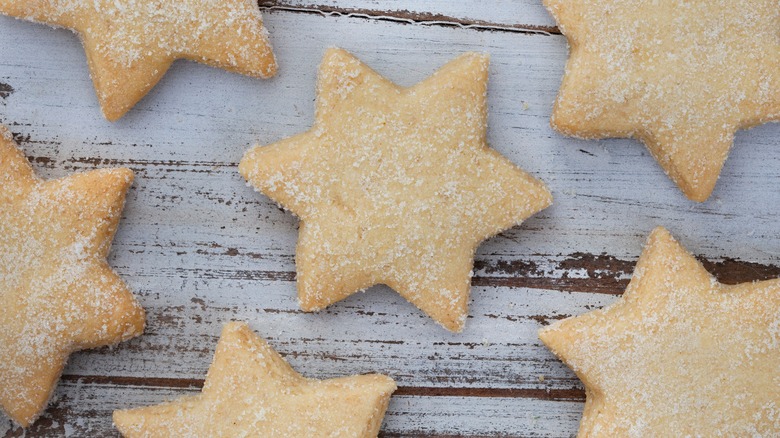13 Common Mistakes Everyone Makes With Sugar Cookies
Baking sugar cookies can be a big task, especially for beginner bakers. Sometimes, you might end up with cookies that are misshapen, undercooked, bland, or just messy overall. If you want to create stunning sugar cookies with an impressive taste and even more impressive look, you need to be aware of a few common mistakes to avoid when making them. Even if your sugar cookies usually turn out fine, there's still always room for improvement.
For instance, if you don't chill the dough long enough, it might be extremely soft and floppy when you transfer the cut-outs onto the tray, which is incredibly irksome. With the proper chilling method, you'll no longer have to deal with that. Or, maybe you unknowingly use the wrong kind of frosting, which makes decorating harder than it needs to be.
Whichever the case, there are many helpful techniques to avoid disappointment. Luckily, you can take advice from a professional baker who can guide you. With my extensive experience in baking sugar cookies, I can assist you in determining what exactly you should and shouldn't do when it comes to this type of baking project.
1. Using the wrong ingredient ratios
You're not alone if you've ever made sugar cookies that spread thin and bled into each other. This usually happens when you don't use the proper ingredient ratios for the recipe. You might assume the butter is the culprit (and it might be if there isn't enough flour to hold it), but too much sugar can also create a runny cookie because it is hygroscopic — a technical word that simply means sugar soaks up moisture in the dough while it's raw. Once your cookies are in the oven, though, that liquid escapes.
This all means you need enough flour to balance out the other ingredients for the cookies to retain their shape. Another common mistake people make is using an incorrect amount of baking soda or powder — too much causes the cookies to have an off taste, while not enough results in dense cookies. Lastly, some people might add extra vanilla extract in an attempt to give the cookies a more intense flavor. Unfortunately, if you overdo it, it produces the opposite effect, making the cookies taste bitter. All of this goes to say that it's crucial to use a tried-and-true recipe and to be cautious when measuring the ingredients.
2. Using imitation vanilla
Sugar cookies have a simple taste, with the vanilla extract being a forward flavor. You might not know, but vanilla enhances sugar's best qualities, bringing out the sweetness, so it plays a vital role in baked goods. Desserts don't turn out nearly as delicious when you use mock products because real vanilla also has a much deeper flavor and aroma. Imitation vanilla is precisely what it sounds like; it isn't actually vanilla but a synthetic liquid that tastes similar to it.
If you want to bake like a pro, you need high-quality vanilla for treats like sugar cookies. When shopping, look for labels that say "pure" vanilla extract and don't contain unnecessary ingredients. In reality, the components should only be vanilla and alcohol. If you don't mind the look of little specks in your bakes, you can even use fresh vanilla beans or vanilla paste in place of the extract. These ingredients impart the cookies with a complex, warm flavor that instantly upgrades them.
3. Neglecting to chill the dough
Although you can skip chilling the dough with other types of cookies, doing so with sugar cookies is a recipe for disaster. If the butter in the dough isn't cold enough, it melts in the oven almost instantly. As a result, it might seep out of your cookies or make them lose shape, leaving you with sloppy results. If you want your sweet treats to look uniform, chilling the dough before and after shaping it is a good idea.
First, place it in the refrigerator for roughly 30 minutes before you roll it so it doesn't become overly soft and difficult to work with. This approach makes cutting the shapes and transferring them to a tray easier. Then, you can place the cut-outs back in the refrigerator for 10 to 15 minutes so they firm up again and bake with no issues. You can also speed up the process by using the freezer for half the amount of time.
4. Rolling the dough to the wrong thickness
Rolling the dough too thick or thin can ruin your baking project, as there's no way to fix this after you bake the cookies. The thickness of the cookies isn't just a presentation issue — it affects how they bake and how delicate they are when you decorate them. If you roll the dough too thin, the baked goods easily crack and don't have the strength to hold decorations or be picked up and put down repeatedly.
On the other hand, overly thick cookies bake unevenly, and the center often remains raw or gummy long after the outer edges are ready. These cookies aren't necessarily the most appetizing thing to bite into either, because they have a dense, cakey mouthfeel that no amount of frosting can fix. Luckily, if you roll the dough ¼ inch thick, you'll find it to be the perfect happy medium. If it's hard for you to estimate, you can always use a ruler as a guide.
5. Adding too much flour to the work surface
One of the most common errors people make is using too much flour when rolling out the dough. Although many recipes suggest adding some flour to the work surface, you mustn't add too much. Otherwise, most of what you put on the table blends into the dough, ruining the texture and making it harder to roll out. It also causes the cookies to have a dry or tough texture when you bake them. All you need to do is lightly sprinkle the flour, but it shouldn't be so thick that you can't see the table underneath.
In between rolling, lift the edges and turn the dough constantly, preventing it from sticking. To avoid this issue, you can also use a clever trick by rolling the dough between parchment or wax paper. With this method, you have less mess to clean up, and you don't need to worry about accidentally adding too much flour to the dough. If it sticks to the paper, place it in the refrigerator or freezer momentarily for it to set, and it should peel right off once it's cooler.
6. Using the dough scraps over and over
When cutting out shapes, people often reuse the dough scraps too much. It's understandable how this happens since you likely want to reduce food waste and use as much of the dough as possible. However, if you're not careful, your dough can become overworked, which gives it a tough, undesirable texture. As a result, it becomes difficult to shape, and the previous cookie cutter marks may be visible when you bake the cookies.
One of the best ways to avoid this is to cut the cookies as close together as possible to avoid creating too many scraps in the first place. Nevertheless, you will inevitably end up with leftover pieces. It doesn't hurt to reroll the dough once or maybe twice, but after that, it's best if you discard it or bake the pieces separately. You can always enjoy them as a snack that you won't necessarily decorate or serve.
7. Working with the wrong cookie cutters
Believe it or not, some cookie cutters are better than others. People often make the mistake of choosing intricate cookie cutters that are difficult to work with. If they have thin edges or details that protrude from the rest of the cookie, they have a higher chance of not turning out right. First, when you cut the dough, separating it from the cutter can be hard, and the thinner parts might rip off. Additionally, after you bake them, the cookie edges are often fragile.
Another downside to these overly fancy shapes is that the cookies bake unevenly. All the tiny parts that poke out tend to bake faster, so they become much darker in color compared to the rest of the sweet treat (or worse, the edges burn entirely). Simplicity is definitely better in this case. Basic shapes are recognizable even without frosting, and they come more alive after you decorate them. So, don't fret. You can still create an exceptionally unique cookie when you take the safer route.
8. Neglecting to prep the equipment
Preparation is always crucial in the kitchen, especially when making sugar cookies. Frequently, people are so focused on perfecting the dough that they overlook other aspects of the project, such as prepping the cookie cutters before they use them. Whether you have a metal, plastic, or other type of cutter, it's not uncommon for the dough to stick to it. Of course, you don't want that to happen because if the dough rips, you must reroll it or try to repair it. Fortunately, there are ways to prevent a sticky cookie-cutter mess.
First, you can dunk the cutters into flour and shake the excess off before you stamp them into the dough. Another option is to grease them with either oil or cooking spray. They just need a light coating to work successfully, so don't drench them or the cookies will turn out greasy. Another blunder people make is forgetting to line the baking sheets with parchment paper. Although it is such a simple step, it can quite literally make or break the final product. For effortless release, spray the sheet pan and press the parchment onto it, especially on the edges, so it doesn't lift during baking.
9. Not practicing decorating techniques first
Decorating sugar cookies requires skill and a steady hand. The design you choose plays a big part in how much practice you need beforehand. However, even with simple outlines, jumping right in without practice is a mistake because the cookies might not turn out how you imagined. They might not even be something you're proud to serve. For folks who don't use piping bags often, getting accustomed to how the icing flows out can take some time, so it's a good idea to bake extra cookies to practice with. If you're a beginner to icing sugar cookies, you can start by using cookie cutters as a guideline.
Start with the sample cookies and press the cutter against them so the icing forms clean edges and doesn't drip. This helps you to create a nice border and fill the center with looser icing. Once you have it down on the sample cookies, you'll feel confident using this technique with the cookies you plan to serve. For drawing designs that aren't borders, such as writing someone's name, there's another easy way to practice. You can write with the icing onto parchment paper to get the hang of it before moving on to the real deal.
10. Transferring them too soon after baking
Although you might be excited about your freshly baked cookies, you mustn't immediately remove them from the baking sheet. If you take a spatula, or worse, try to grab them with your hands, it can make the perfectly shaped cookies slightly crooked because they're still super soft at this stage. Additionally, they might tear, ruining the hard work that you just put forward. That means you'll have to patch them with frosting, which isn't fun.
As a rule of thumb, wait at least five minutes before you touch them because hot cookies are still baking even after you remove them from the oven. They need those few minutes to cool down and firm up. Once their temperature drops slightly, the underside of the cookie will easily peel away from the parchment paper rather than sticking to it. The next step is to transfer them to a cooling rack or a separate tray where they can cool entirely before you decorate them or simply store them. Additionally, placing them in a sealed container or bag too early causes moisture to build up, resulting in soggy cookies, so don't act too soon when moving them to storage either.
11. Using icing that doesn't set
Unfortunately, using a type of icing that doesn't set results in very messy cookies. With super soft icing, you can't stack the cookies or tightly wrap them without them being destroyed, making transportation challenging. What's more, loose frosting melts more easily. This means, you must avoid runny icing simply containing powdered sugar, vanilla, and water or milk. Above all, whipped cream or cream cheese frostings are the main types to avoid. By far, royal icing is the best choice, but buttercream can also work in certain circumstances.
Royal icing is ideal because it sets quickly and creates gorgeous pristine lines when you decorate. Typically, it contains egg whites (fresh or dried), powdered sugar, and vanilla extract. Sometimes, you'll also find meringue powder, xanthan gum, cream of tartar, or other ingredients can help to stabilize it further. Buttercream is much softer and is made with butter, powdered sugar, a dash of salt, and vanilla. When you make it correctly, it doesn't entirely set but forms a crust on the outer layer. If you go with buttercream, use about three times as much sugar as fat to form a crust properly, and be cautious when stacking your cookies.
12. Not sifting powdered sugar for the icing
Whatever you do, don't skip sifting the powdered sugar when you go to make homemade frosting. We agree that pushing clumpy powdered sugar through a sieve is not the most enjoyable experience, but it's even less enjoyable when you try to take shortcuts and end up with chunky frosting instead. Unfortunately, if the frosting has lumps, it has trouble flowing through the piping tip or squeeze bottle that you use to decorate the cookies. It's frustrating to fix at this point since you have to remove the icing and reintroduce it to the mixer to make it smoother.
Some people might opt to spread the icing with a spoon instead of trying to fix it, but this gives the cookies a horrible bumpy presentation. Ultimately, sifting the sugar makes the frosting incredibly smooth, which is precisely what you want. So, even if you think your sugar doesn't necessarily need it, just take five minutes and utilize your handy sieve. It saves you time in the long run.
13. Not experimenting with decorations
Many people decorate sugar cookies using plain icing and sprinkles, which can feel repetitive. Sadly, you miss many creative opportunities when you don't step outside your comfort zone. Even for people who are inexperienced in the kitchen, there are plenty of ways to make showstopping cookies. For instance, one of the easiest ways to upgrade the appearance is to add color to the icing.
You can separate it into multiple bowls and make several colors to give your cookie batch variety. Also, if you don't feel comfortable piping or spreading the frosting, you can always melt some chocolate instead and drizzle abstract lines over the cookies, which looks incredibly elegant. Another option is to skip the rainbow sprinkles and opt for fancier ones, such as edible pearls or themed sprinkles suitable for a holiday or specific event.
Lastly, you can use a unique trick to give your sugar cookies a marbled look. Take some gel food dye and drip it into the icing, then lightly swirl it without thoroughly mixing it in. There should be a clear distinction between the white icing and the colored parts. Then, you can carefully dunk the top part of your sugar cookie into the icing, giving a beautiful marbled display.

